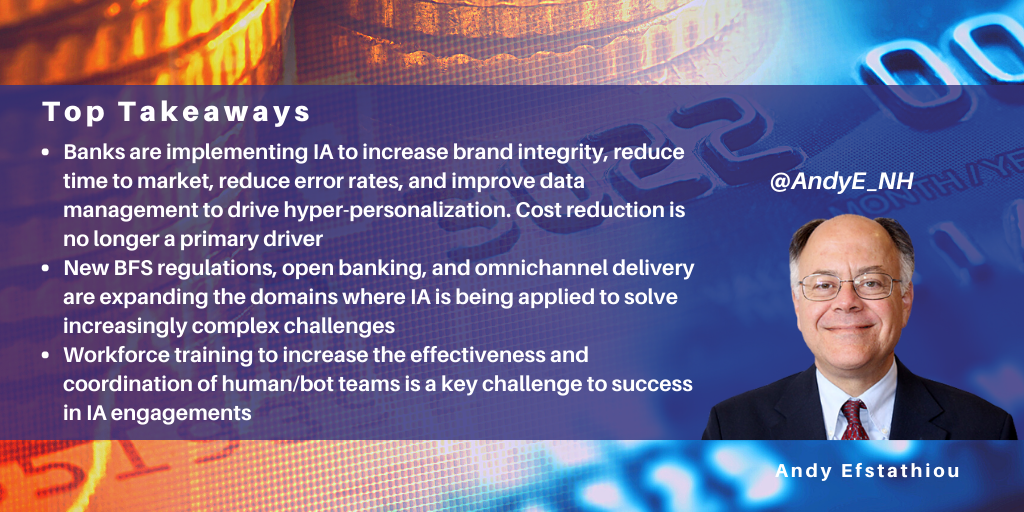posted on Jul 19, 2023 by Andy Efstathiou

NelsonHall has just completed the research for a market assessment and forecast report on Transforming Intelligent Automation Services in Banking. We found that banks have accelerated the adoption of IA services in operations over the past two years, a shift that has been driven by:
- Declining operating margins on legacy businesses
- Pursuit of new customer demographics to replace the older customer cohort, which requires banks to launch and deliver new products digitally
- Changing business models (primarily to open banking) driven by regulations.
By transitioning operational delivery from manual to digital processing, financial institutions can drive:
- Greater brand integrity from consistent execution
- Faster time to market for new and seasonal products
- Reduced error rates which reduce costs and enable settlements on shortened deadlines
- Improved data management, which enables hyper-personalization.
IA adoption pattern
Tier-one banks have been the primary adopters, with every tier-one bank having an active IA program. Regional banks and industry services providers are increasing their commitment to IA projects. Only 30% of regional banks had IA programs three years ago; today, 75% of these banks have active IA programs. Local banks are where regional banks were three years ago, with 30% having active IA programs. Capital markets firms are late adopters but are beginning to adopt IA services to serve high-net-worth customers and meet reduced settlement deadlines.
The pace of lower-tier banks starting IA programs is accelerating, and three years from now we expect all financial institutions to be fully committed to IA in their business. The growth in clients and project scope will drive growth rates of IA revenues to 16.5% per year for the next five years to 2028. Managed services for IA operations will grow 17% over the forecast period. Growth has been fastest in mature markets, but now the emerging and APAC markets are growing faster than mature ones.
Financial institutions are focusing their efforts on the following:
- Operationalizing IA use cases: banks are deemphasizing the building of POCs to find ways to use IA and are instead concentrating on identifying high-impact use cases that can be operationalized to create value
- Improving data management: banks are changing their focus from improving data management within silos to improving data sourcing, management, and reporting across silos
- Expanding the pool of skilled employees to implement IA: banks are focusing on implementing tools (such as low/no code) that enable non-technical employees with domain expertise to build IA solutions with business impact at lower transaction volumes
- Enabling human/bot coordination and increased effectiveness: these initiatives are the least mature. Currently, banks are coordinating human/bot routines on customer-facing activities (i.e., customer contact, advisory, and lending origination). Banks are beginning to explore human/bot coordination in back-office settings, including settlements, reconciliations, and collateral management.
How vendors are enabling IA initiatives
Vendors are helping clients accelerate their IA initiatives by delivering enablement in four areas:
- Process identification and mapping: undertaking comprehensive process discovery, reengineering, automation, and embedding intelligence into processes that were previously unmapped and manual. The goal is to expand the footprint of automation in operations until all processes are digital or at least touched by digital services
- Data management: delivering three critical areas of data management:
- Data sourcing and scrubbing, focusing on standardizing data across a bank’s silos of products, markets, and sub-industries
- Expanding the range of data banks utilize into voice, image, and unstructured data
- Implementing predictive AI to support customer interactions and service
- Productizing IA offerings: the IA market has developed quickly. Most vendors have capabilities but not productized offerings. Vendors have developed productized offerings in the past two years to support lower-tier financial institutions and bank subsidiaries. These target clients are looking for rapid deployment of best practice capabilities at low cost
- Workforce effectiveness: delivering three areas of improvement:
- Developing IP, which supports employees and stakeholders in delivering IA projects with less training and fewer technical skills. This type of IP includes COEs, accelerators, APIs, low/no-code solutions, and solution libraries
- Training, including online, in-person, hackathons, and academies
- Coordination of worker/bot teams with user journey design tools and training.
Outlook
IA services in BFS are continuing to evolve new offerings and use cases. Developments include:
- New regulations, including:
- Open banking regulations, which will necessitate automating processes with third parties. This will involve integrating processes across counterparties not part of the initial financial institution. Integrating and automating processes across enterprises raises the challenge of coordinating governance
- Instant payments, which require increased automation to reduce error rates and faster settlement
- Faster securities settlement times, which require reduced error rates and faster settlement
- Application of relevant regulations to customers as they move across markets with differing regulations
- Data management, including:
- Management of third-party vendors and agents
- Use of increasingly powerful analytics requiring it to be used judiciously as well as effectively
- Increased application of IA to the omnichannel environment to:
- Increase customer choice of how to interact with banks
- Support customer interpretation of offers with visual and audio information
- Support the financial institution in understanding customer requirements and sentiment from real-time feedback analysis
- Expanding automation activities from customer-facing processes to back office and fulfillment processes. Automation to date has focused on customer interactions. Automation and AI will increasingly be applied to fulfillment processes and integrated into front-office processes.
Increasingly, business value from IA projects is less about cost savings and more about business agility. The ability to bring products to market faster and provide operational support for rapidly changing offerings is more important than cost savings on sunsetting offerings.
